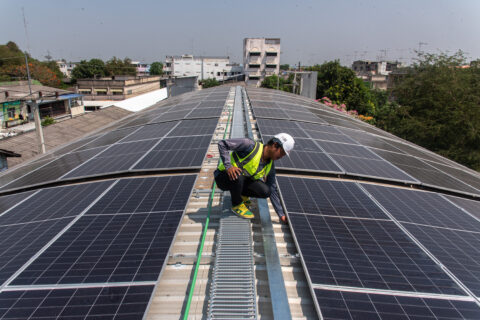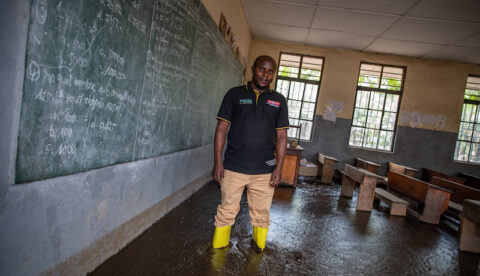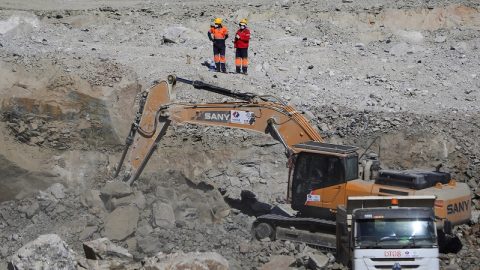Global temperatures in 2023 blew past expectations to set the warmest year on record, even topping 1.5C in one of the main datasets.
This warmth has continued into 2024, meaning that this year is also on track to potentially pass 1.5C in one or more datasets.
Crossing 1.5C in one or even two years is not the same as exceeding the 1.5C limit under the Paris Agreement. The goal is generally considered to refer to long-term warming, rather than annual temperatures that include the short-term influence of natural fluctuations in the climate, such as El Niño.
Nonetheless, recent warming has led to renewed debate around whether the world might imminently pass the 1.5C Paris Agreement limit – sooner than climate scientists and Intergovernmental Panel on Climate Change (IPCC) have previously estimated.
Here, Carbon Brief provides an updated analysis of when the world will likely exceed the Paris 1.5C limit (in a scenario where emissions are not rapidly cut), using both the latest global surface temperature data and climate model simulations.
The findings show that, while the best estimate for crossing 1.5C has moved up by approximately two years compared to Carbon Brief’s earlier 2020 analysis, it remains most likely to happen in the late 2020s or early 2030s – rather than in the next few years.
Understanding global temperature targets
Human emissions of CO2 and other greenhouse gasses have substantially warmed the planet over the past 150 years. On top of this human-driven warming, there is year-to-year natural variability largely associated with El Niño and La Niña events.
A big El Niño or La Niña event can result in global temperatures up to 0.2C warmer or cooler, respectively, than they would otherwise be.
As the world has been warming by around 0.2C per decade, a large El Niño event can represent an early look at what typical global temperatures will be a decade in the future. Or, to put it another way, human emissions are adding a permanent super-El Niño’s worth of heat to the climate system each decade.
In the 2015 Paris Agreement, the international community agreed to limit warming to well-below 2C above pre-industrial levels and “pursue efforts to limit the temperature increase to 1.5C”. While there is no set definition for the time period against which the goal is measured, it is generally interpreted to refer to long-term, human-driven warming.
For example, the IPCC’s recently completed sixth assessment report (AR6) uses the midpoint of a 20-year period as a way to avoid overinterpreting short-term natural variability.
While a useful approach, this definition has the unfortunate side-effect that scientists will not know for sure that the world passed 1.5C until 10 years after it has happened.
This has led the community to propose a number of alternative approaches, such as Carbon Brief’s 2020 analysis and a 2023 Nature commentary by Prof Richard Betts and colleagues at the UK Met Office.
An updated approach for determining exceedance
Here, Carbon Brief provides an update to our 2020 analysis of both observations and the latest generation of climate models to assess when the world will likely pass the 1.5C limit across different surface temperature datasets.
While the IPCC’s 20-year average is one approach to remove short-term variability, it comes with the important downside of not being able to extend up to the present day. An alternative approach is a smoothed average using a local regression (LOWESS).
LOWESS provides an estimated value at each point in time based on a weighting where nearby points are given the highest weights and those further away are given less weight. It is an approach commonly used in timeseries analysis that can account for changes in the behaviour of data over time without assuming it is linear.
However, LOWESS approaches still require a choice on the part of the user; namely, how many nearby points should be considered when determining the smoothed average. The figure below shows three potential options that could be used: a window of the nearest 10 years, 20 years or 30 years around each point.
The data shown are a composite average of four different global surface temperature records – NASA’s GISTEMP; NOAA’s GlobalTemp; Hadley/UEA’s HadCRUT5; and Berkeley Earth – that extend back into the 1800s.

Annual global mean surface temperatures from a composite average of NASA’s GISTEMP, NOAA’s GlobalTemp, Hadley/UEA’s HadCRUT5, and Berkeley Earth (black dots) along with LOWESS fits using 10-year, 20-year, and 30-year windows. Chart by Carbon Brief.
In this case, both 20-year and 30-year windows show similar long-term changes in temperature, while a shorter 10-year window does not fully remove short-term variability associated with El Niño and La Niña events.
For this analysis, Carbon Brief selected a 30-year window for removing natural variability, though a 20-year window would have given nearly identical results. (As discussed above, there are a number of alternative approaches that could be used. These are assessed in the UK Met Office’s Climate Dashboard, though they all give comparable results to the LOWESS approach used here.)
To determine when the world will pass 1.5C and 2C, Carbon Brief combines smoothed averages of both observed temperatures and climate model projections.
The observed temperatures are used to determine the level of warming to date – 1.3C in the composite average – while climate models are used to assess the range of possible warming into the future. This approach has an advantage over just using climate models as it avoids any historical mismatch between modelled and real-world temperatures.
The figure below shows the combined smoothed average from the observations and climate models, with the climate models normalised to the observations in 2023. Global temperatures are assessed to be 1.3C in 2023, with a wide range of possible future warming determined by the spread in warming after 2023 across 37 different climate models in the CMIP6 ensemble using the SSP2-4.5 current-policy-type scenario.

Annual global average surface temperatures from the composite average (black dots) along the 30-year LOWESS fit (black line), combined with 37 CMIP6 models smoothed using the same 30-year LOWESS fit. Models and observations are aligned using the smoothed average values for 2023. Chart by Carbon Brief.
This approach suggests that the world will pass 1.5C around the year 2030 (representing the 50th percentile, or central estimate, of all the model runs), with a range of anywhere from 2028 (5th percentile) up to 2036 (95th percentile).
Similarly, the world will pass 2C around the year 2048, with a range of 2040 to 2062 across all models assessed.
The figure below shows distribution of exceedance years (that is, the year in which the target is exceeded) across all of the different CMIP6 models. The width of the plot indicates the portion of models that show the temperature limit passed in a given year – the wider the plot, the more agreement across the models.

The results are broadly similar to Carbon Brief’s 2020 analysis, though the best estimate of when the world will pass 1.5C has moved up from 2032 to 2030, reflecting both a higher estimate of warming to date (including the development of HadCRUT5) and an inclusion of more CMIP6 model runs than were available at the time.
The 5th and 95th percentile has narrowed to 2028-36 compared to 2026-42 in the 2020 analysis, showing the impact of three additional years of data on reducing the resulting model spread.
Sensitivity to the choice of datasets
While the averaging of different datasets into a composite average follows the approach used in the IPCC AR6 and by the WMO, it somewhat obscures important differences in estimates of warming since pre-industrial times across different research groups.
While the long-term warming the world has experienced in the composite average is 1.3C as of 2023 (similar to the results in the new Forster et al study), applying the same LOWESS smoothing approach to each individual record yields fairly different results, ranging from as low as 1.22C to 1.41C across the four different groups:
- Composite Average: 1.30C
- Berkeley Earth: 1.41C
- HadCRUT5: 1.30C
- NASA GISTEMP: 1.24C
- NOAA GlobalTemp: 1.22C
These differences reflect a number of factors, including what land station data is included in each record, the ocean sea surface temperature datasets used and how different groups fill in the gaps between observations – particularly in the early part of the record when station data is more sparse.
The table below gives the resulting 1.5C exceedance years when Carbon Brief’s approach is applied to each different temperature record:
| Projected year of 1.5C breach | |||
|---|---|---|---|
| Dataset | 50th percentile | 5th percentile | 95th percentile |
| Composite | 2030 | 2028 | 2036 |
| Berkeley Earth | 2027 | 2025 | 2031 |
| HadCRUT5 | 2030 | 2028 | 2036 |
| NASA GISTEMP | 2032 | 2029 | 2040 |
| NOAA GlobalTemp | 2033 | 2030 | 2041 |
Using the Berkeley Earth record gives a central estimate of passing 1.5C as early as 2027 (ranging from 2025 to 2031), while NOAA gives an estimate as late as 2033 (2030 to 2041).
Similarly, here are the results for the 2C exceedance year:
| Projected year of 2C breach | |||
|---|---|---|---|
| Dataset | 50th percentile | 5th percentile | 95th percentile |
| Composite | 2048 | 2040 | 2062 |
| Berkeley Earth | 2045 | 2037 | 2056 |
| HadCRUT5 | 2048 | 2040 | 2062 |
| NASA GISTEMP | 2050 | 2041 | 2067 |
| NOAA GlobalTemp | 2051 | 2042 | 2068 |
It is worth noting that there is no “correct” answer as to the best surface temperature record to use. Rather, the range of results across the different records represent real uncertainty around when the world will pass 1.5C and 2C.
Other approaches get similar results
This analysis is far from the first time the scientific community has asked when the world will pass various climate limits or how to best calculate the level of warming the world has experienced to date.
Copernicus/ECMWF provide a regularly updated “global temperature trend monitor” that uses a more simple approach – a linear trend over the past 30 years – to assess when global temperatures will likely exceed 1.5C in their ERA5 dataset.

This approach gives a slightly later date, 2033, than the climate model-based approach Carbon Brief uses. This reflects the fact that most models anticipate a modest acceleration in the rate of warming that might not be fully captured using a linear trend over the past 30 years.
An alternative approach to determining when the world will pass 1.5C is to use the “assessed warming projections” developed for AR6. These assessed warming projections more closely match observed temperatures than the full CMIP6 ensemble.
They also provide a narrower range of future warming than the full set of CMIP6, as they give less weight to “hot models” in CMIP6 that are inconsistent with the IPCC’s assessment of the likely range of climate sensitivity.

Annual global average surface temperatures from the composite average (black dots) along the 30-year LOWESS fit (red line), combined the AR6 assessed warming projection for SSP2-4.5 as published and without any baseline alignment. Chart by Carbon Brief.
In addition, AR6 features an estimate of 1.5C exceedance dates based on the ScenarioMIP assessment of CMIP6 models (and previously covered by Carbon Brief here).
These three different approaches are compared to Carbon Brief’s new assessment in the table below:
| Approach | 1.5C exceedance year |
|---|---|
| Carbon Brief (Composite, SSP2-4.5) | 2030 (2028 to 2036) |
| Copernicus | 2033 |
| AR6 Assessed Warming (SSP2-4.5) | 2031 (2024 to 2043) |
| AR6 ScenarioMIP (SSP2-4.5) | 2030 (2021 to 2046) |
Both AR6 approaches include a wider range than the Carbon Brief approach as they rely on models that have differing estimates of current global temperatures relative to pre-industrial.
For example, the AR6 assessed warming projections give a best estimate of 2023 global temperatures (in the absence of short-term natural variability) as 1.31C, with a range from as low as 1.15C to as high as 1.48C. However, these are comparable to the range of warming to date (1.22C to 1.41C) across the different surface temperature records.
There is no single best way to assess when the world will likely pass 1.5C. But both Carbon Brief’s approach and those of other groups all agree it will most likely happen in the late 2020s or early 2030s in a world (SSP2-4.5) where global emissions remain around current levels.
The post Analysis: What record global heat means for breaching the 1.5C warming limit appeared first on Carbon Brief.
Analysis: What record global heat means for breaching the 1.5C warming limit
Climate Change
Colombia proposes expert group to advance talks on minerals agreement
Colombia wants countries to discuss options for a global agreement to ensure that the extraction, processing and recycling of minerals – including those needed for the clean energy transition – don’t harm the environment and human wellbeing.
The mineral-rich nation is proposing to create an expert group to “identify options for international instruments, including global and legally-binding instruments, for coordinated global action on the environmentally sound management of minerals and metals through [their] full lifecyle”.
Colombia hopes this will eventually lead to an agreement on the need for an international treaty to define mandatory rules and standards that would make mineral value chains more transparent and accountable.
The proposal was set out in a draft resolution submitted to the UN Environment Assembly (UNEA) earlier this week and seen by Climate Home News. UNEA, which is constituted of all UN member states, is the world’s top decision-making body for matters relating to the environment. The assembly’s seventh session will meet in Kenya in December to vote on countries’ proposals.
Soaring demand for the minerals used to manufacture clean energy technologies and electric vehicles, as well as in the digital, construction and defence industries have led to growing environmental destruction, human rights violations and social conflict.
Colombia argues there is an “urgent need” to strengthen global cooperation and governance to reduce the risks to people and the planet.
Options for a global minerals agreement
The proposal is among a flurry of initiatives to strength global mineral governance at a time when booming demand is putting pressure on new mining projects.
Colombia, which produces emeralds, gold, platinum and silver for exports, first proposed the idea for a binding international agreement on minerals traceability and accountability on the sidelines of the UN biodiversity talks it hosted in October 2024.
Since then, the South American nation has been quietly trying to drum up support for the idea, especially among African and European nations.
Its draft resolution to UNEA7 contains very few details, leaving it open for countries to discuss what kind of global instrument would be best suited to make mineral supply chains more transparent and sustainable.
Does the world need a global treaty on energy transition minerals?
Colombia says it wants the expert group to build on other UN initiatives, including a UN Panel on Critical Energy Transition Minerals, which set out seven principles to ensure the mining, processing and recycling of energy transition minerals are done responsibly and benefit everyone.
The group would include technical experts and representatives from international and regional conventions, major country groupings as well as relevant stakeholders.
It would examine the feasibility and effectiveness of different options for a global agreement, consider their costs and identify measures to support countries to implement what is agreed.
The resolution also calls for one or two meetings for member states to discuss the idea before the UNEA8 session planned in late 2027, when countries would decide on a way forward.
No time to lose for treaty negotiations
Colombia’s efforts to advance global talks on mineral supply chains have been welcomed by resource experts and campaigners. But not everyone agrees on the best strategy to move the discussion forward at a time when multilateralism is coming under attack.
Johanna Sydow, a resource policy expert who heads the international environmental policy division of the Heinrich-Böll Foundation, said she had hoped that the resolution would explicitly call for negotiations to begin on an international minerals treaty.
“Treaty negotiations take a long time. If you don’t even start with it now, it will take even longer. I don’t see how in two or three years it will be easier to come to an agreement,” she told Climate Home.
Despite the geopolitical challenges, “we need joint rules to prevent a huge race to the bottom for [mineral] standards”. That could start with a group of countries coming together and starting to enforce joint standards for mining, processing and recycling minerals, she said.
But any meaningful global agreement on mineral supply chains would require backing from China, the world’s largest processor of minerals, which dominates most of the supply chains. And with Colombia heading for an election in May, it will need all the support it can get to move its proposal forward.
‘Voluntary initiative won’t cut it’
Juliana Peña Niño, Colombia country manager at the Natural Resource Governance Institute, is more optimistic. “Colombia’s leadership towards fairer mineral value chains is a welcome step,” she told Climate Home News.
“At UNEA7, we need an ambitious debate that gives the proposed expert group a clear mandate to advance concrete next steps — not delay decisions — and that puts the voices of those most affected at the centre. One thing is clear: the path forward must ultimately deliver a binding instrument, as yet another voluntary initiative simply won’t cut it,” she said.
More than 50 civil society groups spanning Latin America, Africa and Europe previously described Colombia’s work on the issue as “a chance to build a new global paradigm rooted in environmental integrity, human rights, Indigenous Peoples’ rights, justice and equity”.
“As the energy transition and digitalisation drive demand for minerals, we cannot afford to repeat old extractive models built on asymmetry – we must redefine them,” they wrote in a statement.
Main image: The UN Environment Assembly is hosted in Nairobi, Kenya. (Natalia Mroz/ UN Environment)
The post Colombia proposes expert group to advance talks on minerals agreement appeared first on Climate Home News.
Colombia proposes expert group to advance talks on minerals agreement
Climate Change
California Sanctions Stark Disparities in Pesticide Exposure During Pregnancy
If you’re young, pregnant and Latina, chances are you live near agricultural fields sprayed with higher levels of brain-damaging organophosphate pesticides.
A baby in the womb has few defenses against industrial petrochemicals designed to kill.
California Sanctions Stark Disparities in Pesticide Exposure During Pregnancy
Climate Change
DeBriefed 3 October 2025: UK political gap on climate widens; Fossil-fuelled Typhoon Ragasa; ‘Overshoot’ unknowns
Welcome to Carbon Brief’s DeBriefed.
An essential guide to the week’s key developments relating to climate change.
This week
Shattered climate consensus
FRACKING BAN: UK energy secretary Ed Miliband has announced that the government will bring forward its plans to permanently ban fracking, in a move designed to counter a promise from the hard-right Reform party to restart efforts to introduce the practice, the Guardian said. In the same speech, Miliband said Reform’s plans to scrap clean-energy projects would “betray” young people and future generations, the Press Association reported.
ACT AXE?: Meanwhile, Kemi Badenoch, leader of the Conservatives, pledged to scrap the 2008 Climate Change Act if elected, Bloomberg reported. It noted that the legislation was passed with cross-party support and strengthened by the Conservatives.
‘INSANE’: Badenoch faced a backlash from senior Tory figures, including ex-prime minister Theresa May, who called her pledge a “catastrophic mistake”, said the Financial Times. The newspaper added that the Conservatives were “trailing third in opinion polls”. A wide range of climate scientists also condemned the idea, describing it as “insane”, an “insult” and a “serious regression”.
Around the world
- CLIMATE CRACKDOWN: The US Department of Energy has told employees in the Office of Energy Efficiency and Renewable Energy to avoid using the term “climate change”, according to the Guardian.
- FOREST DELAY: Plans for Brazil’s COP30 flagship initiative, the tropical forests forever fund, are “suffer[ing] delays” as officials remain split on key details, Bloomberg said.
- COP MAY BE ‘SPLIT’: Australia could “split” the hosting of the COP31 climate summit in 2026 under a potential compromise with Turkey, reported the Guardian.
- DIVINE INTERVENTION: Pope Leo XIV has criticised those who minimise the “increasingly evident” impact of global warming in his first major climate speech, BBC News reported.
€44.5 billion
The cost of extreme weather and climate change in the EU in the last four years – two-and-a-half times higher than in the decade to 2019, according to a European Environment Agency report covered by the Financial Times.
Latest climate research
- Fossil-fuelled climate change caused around 36% of Typhoon Ragasa’s direct damage to homes and properties in southern China, according to a rapid impact attribution study | Imperial Grantham Institute – Climate Change and the Environment
- Some 86% of the global population are concerned about climate change, according to a survey of 280,000 people in 142 countries and regions | Climate Policy
- A global shift towards a “planetary health diet” could slash emissions and save tens of thousands of lives each day | EAT-Lancet Commission 2025 report
(For more, see Carbon Brief’s in-depth daily summaries of the top climate news stories on Monday, Tuesday, Wednesday, Thursday and Friday.)
Captured

Clean energy has met 100% of Great Britain’s electricity demand for a record 87 hours this year so far, according to new Carbon Brief analysis. This is up from just 2.5 hours in 2021 and 64.5 hours in all of 2024. The longest stretch of time where 100% of electricity demand was met by clean energy stands at 15 hours, from midnight on 25 May 2025 through to 3pm on 26 May, according to the analysis.
Spotlight
‘Overshoot’ unknowns
As the chances of limiting global warming to 1.5C dwindle, there is increasing focus on the prospects for “overshooting” the Paris Agreement target and then bringing temperatures back down by removing CO2 from the atmosphere.
At the first-ever Overshoot Conference in Laxenburg, Austria, Carbon Brief asks experts about the key unknowns around warming “overshoot”.
Sir Prof Jim Skea
Chair of the Intergovernmental Panel on Climate Change (IPCC) and emeritus professor at Imperial College London’s Centre for Environmental Policy
So there are huge knowledge gaps around overshoot and carbon dioxide removal (CDR). As it’s very clear from the themes of this conference, we don’t altogether understand how the Earth would react in taking CO2 out of the atmosphere.
We don’t understand the nature of the irreversibilities and we don’t understand the effectiveness of CDR techniques, which might themselves be influenced by the level of global warming, plus all the equity and sustainability issues surrounding using CDR techniques.
Prof Kristie Ebi
Professor at the University of Washington’s Center for Health and the Global Environment
There are all kinds of questions about adaptation and how to approach effective adaptation. At the moment, adaptation is primarily assuming a continual increase in global mean surface temperature. If there is going to be a peak – and of course, we don’t know what that peak is – then how do you start planning? Do you change your planning?
There are places, for instance when thinking about hard infrastructure, [where overshoot] may result in a change in your plan – because as you come down the backside, maybe the need would be less. For example, when building a bridge taller. And when implementing early warning systems, how do you take into account that there will be a peak and ultimately a decline? There is almost no work in that. I would say that’s one of the critical unknowns.
Dr James Fletcher
Former minister for public service, sustainable development, energy, science and technology for Saint Lucia and negotiator at COP21 in Paris.
The key unknown is where we’re going to land. At what point will we peak [temperatures] before we start going down and how long will we stay in that overshoot period? That is a scary thing. Yes, there will be overshoot, but at what point will that overshoot peak? Are we peaking at 1.6C, 1.7C, 2.1C?
All of these are scary scenarios for small island developing states – anything above 1.5C is scary. Every fraction of a degree matters to us. Where we peak is very important and how long we stay in this overshoot period is equally important. That’s when you start getting into very serious, irreversible impacts and tipping points.
Prof Oliver Geden
Senior fellow and head of the climate policy and politics research cluster at the German Institute for International and Security Affairs and vice-chair of IPCC Working Group III
[A key unknown] is whether countries are really willing to commit to net-negative trajectories. We are assuming, in science, global pathways going net-negative, with hardly any country saying they want to go there. So maybe it is just an academic thought experiment. So we don’t know yet if [overshoot] is even relevant. It is relevant in the sense that if we do, [the] 1.5C [target] stays on the table. But I think the next phase needs to be that countries – or the UNFCCC as a whole – needs to decide what they want to do.
Prof Lavanya Rajamani
Professor of international environmental law at the University of Oxford
I think there are several scientific unknowns, but I would like to focus on the governance unknowns with respect to overshoot. To me, a key governance unknown is the extent to which our current legal and regulatory architecture – across levels of governance, so domestic, regional and international – will actually be responsive to the needs of an overshoot world and the consequences of actually not having regulatory and governance architectures in place to address overshoot.
Watch, read, listen
FUTURE GAZING: The Financial Times examined a “future where China wins the green race”.
‘JUNK CREDITS’: Climate Home News reported on a “forest carbon megaproject” in Zimbabwe that has allegedly “generated millions of junk credits”.
‘SINK OR SWIM’: An extract from a new book on how the world needs to adapt to climate change, by Dr Susannah Fisher, featured in Backchannel.
Coming up
- 7 October: International Energy Agency (IEA) renewables 2025 report launch
- 8-10 October: World summit of Indigenous peoples and nature, Abu Dhabi, UAE
- 9-15 October: International Union for the Conservation of Nature (IUCN) 2025 congress, Abu Dhabi, UAE
Pick of the jobs
- UK government foreign, commonwealth and development office, senior climate policy adviser | Salary: CA$93,207. Location: Calgary, Canada
- Wellcome Trust, senior research manager, climate and health | Salary: £64,800. Location: London
- Bloomberg, product manager – climate, nature and sustainability regulations | Salary: Unknown. Location: London
DeBriefed is edited by Daisy Dunne. Please send any tips or feedback to debriefed@carbonbrief.org.
This is an online version of Carbon Brief’s weekly DeBriefed email newsletter. Subscribe for free here.
The post DeBriefed 3 October 2025: UK political gap on climate widens; Fossil-fuelled Typhoon Ragasa; ‘Overshoot’ unknowns appeared first on Carbon Brief.
-
Climate Change2 years ago
Spanish-language misinformation on renewable energy spreads online, report shows
-
Climate Change Videos2 years ago
The toxic gas flares fuelling Nigeria’s climate change – BBC News
-
Climate Change2 months ago
Guest post: Why China is still building new coal – and when it might stop
-

 Greenhouse Gases1 year ago
Greenhouse Gases1 year ago嘉宾来稿:满足中国增长的用电需求 光伏加储能“比新建煤电更实惠”
-

 Climate Change1 year ago
Climate Change1 year ago嘉宾来稿:满足中国增长的用电需求 光伏加储能“比新建煤电更实惠”
-
Greenhouse Gases2 months ago
Guest post: Why China is still building new coal – and when it might stop
-

 Carbon Footprint1 year ago
Carbon Footprint1 year agoUS SEC’s Climate Disclosure Rules Spur Renewed Interest in Carbon Credits
-
Renewable Energy3 months ago
US Grid Strain, Possible Allete Sale















